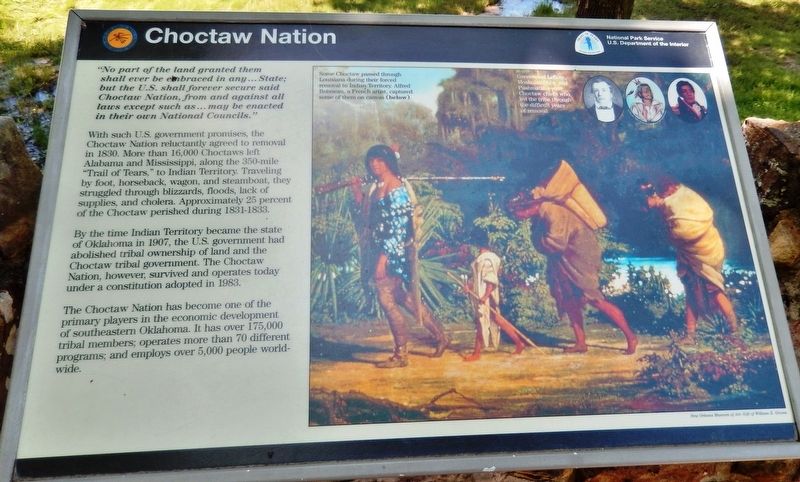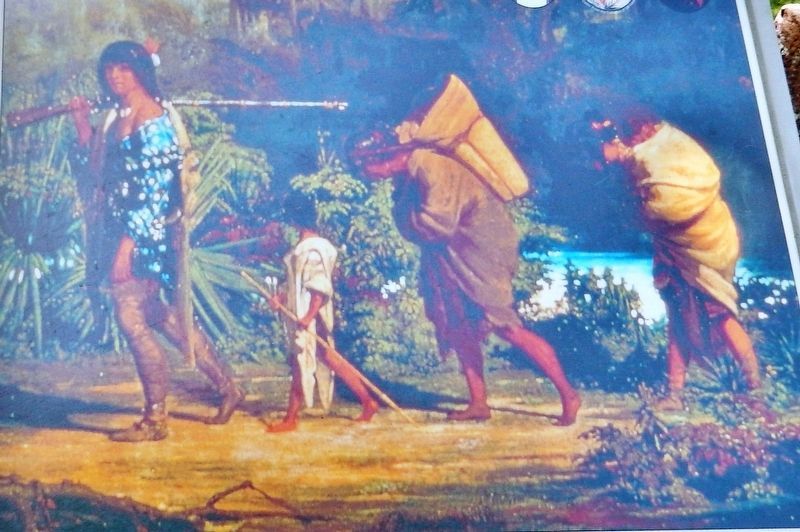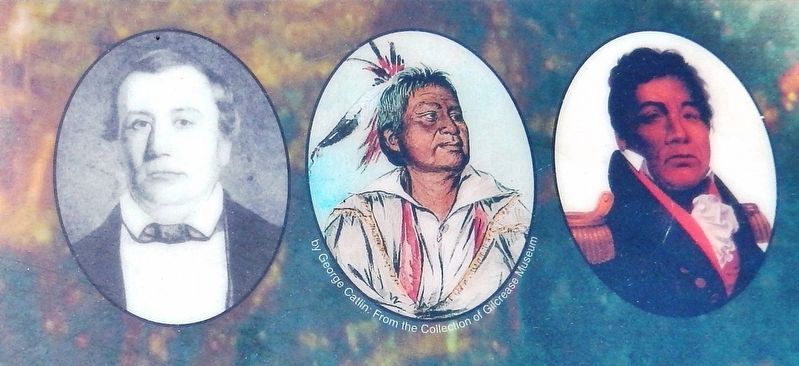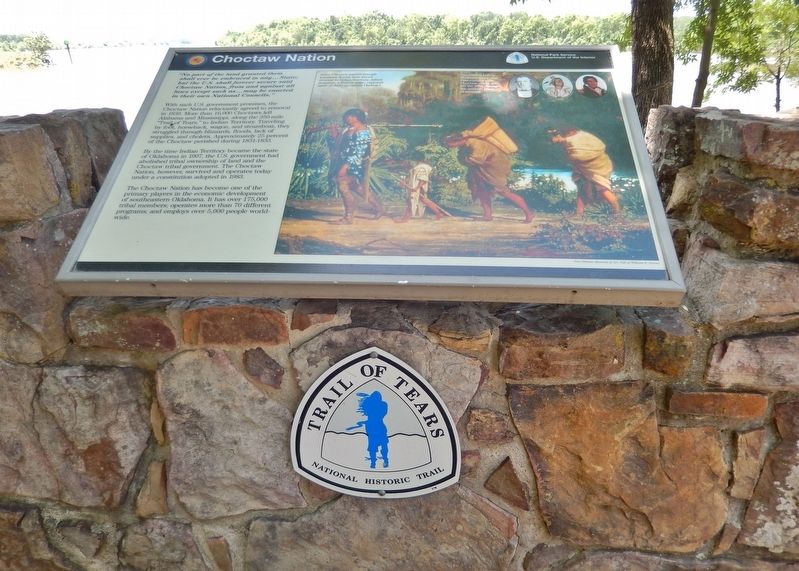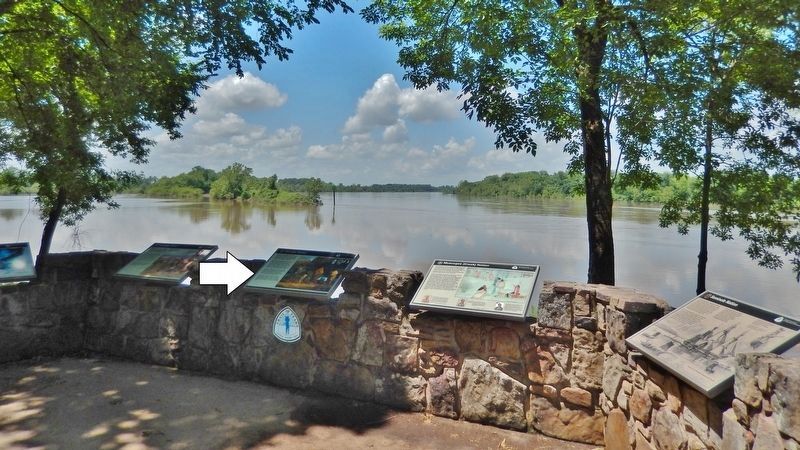Fort Smith in Sebastian County, Arkansas — The American South (West South Central)
Choctaw Nation
"No part of the land granted them shall ever be embraced in any… State; but the U.S. shall forever secure said Choctaw Nation, from and against all laws except such as… may be enacted in their own National Councils."
With such U.S. government promises, the Choctaw Nation reluctantly agreed to removal in 1830. More than 16,000 Choctaws left Alabama and Mississippi, along the 350-mile “Trail of Tears,” to Indian Territory. Traveling by foot, horseback, wagon, and steamboat, they struggled through blizzards, floods, lack of supplies, and cholera. Approximately 25 percent of the Choctaw perished during 1831-1833.
By the time Indian Territory became the state of Oklahoma in 1907, the U.S. government had abolished tribal ownership of land and the Choctaw tribal government. The Choctaw Nation, however, survived and operates today under a constitution adopted in 1983.
The Choctaw Nation has become one of the primary players in the economic development of southeastern Oklahoma. It has over 175,000 tribal members; operates more than 70 different programs; and employs over 5,000 people world-wide.
Erected by National Park Service, U.S. Department of the Interior.
Topics and series. This historical marker is listed in this topic list: Native Americans . In addition, it is included in the Trail of Tears series list. A significant historical year for this entry is 1830.
Location. 35° 23.266′ N, 94° 26.001′ W. Marker is in Fort Smith, Arkansas, in Sebastian County. Marker can be reached from the intersection of Parker Avenue and South 3rd Street. Marker is located on the Fort Smith National Historic Site grounds, near Belle Point on the west side of the fort, overlooking the Arkansas River. Touch for map. Marker is at or near this postal address: 301 Parker Avenue, Fort Smith AR 72901, United States of America. Touch for directions.
Other nearby markers. At least 8 other markers are within walking distance of this marker. Muscogee (Creek) Nation (here, next to this marker); Chickasaw Nation (here, next to this marker); Seminole Nation (here, next to this marker); Cherokee Nation (a few steps from this marker); Request Denied (within shouting distance of this marker); Osage Nation (about 300 feet away, measured in a direct line); Abandoned and Forgotten (about 300 feet away); Establishing Fort Smith (about 300 feet away). Touch for a list and map of all markers in Fort Smith.
More about this marker. A Trail of Tears National Historic Trail interpretive site.
Also see . . .
1. Choctaw History. The Choctaws were the first of the five great southern tribes of the United
States to be moved to Oklahoma by the Treaty of Dancing Rabbit Creek in 1830. Over 20,000 Choctaws moved on this long journey, with many of the Choctaw people not surviving this removal. (Submitted on October 2, 2020, by Cosmos Mariner of Cape Canaveral, Florida.)
2. Greenwood LeFlore (Wikipedia). A wealthy and regionally influential Choctaw of mixed-race, who belonged to the Choctaw elite due to his mother's rank, LeFlore had many connections in state and federal government. In 1830 LeFlore led other chiefs in signing the Treaty of Dancing Rabbit Creek, which ceded the remaining Choctaw lands in Mississippi to the US government and agreed to removal to Indian Territory. (Submitted on October 2, 2020, by Cosmos Mariner of Cape Canaveral, Florida.)
3. Chief Moshulatubbee. He was dignified in bearing, of fine physique, steady and thoughtful in disposition. Moshulatubbee was one of the three head chiefs who signed the early Choctaw treaties with the United States, including that at Dancing Rabbit Creek in 1830, which provided for the removal of the Choctaws from Mississippi. (Submitted on October 2, 2020, by Cosmos Mariner of Cape Canaveral, Florida.)
4. Pushmataha. The hero of the Choctaws, and without doubt one of the greatest of all American Indians, was A-Push-ma-ta-ha-hu-bi, commonly known as Pushmataha.
He was born about 1764 in the present State of Mississippi. He became familiar with the land of Oklahoma, where later his people were to come, and knowing its value, he did not, as some others, oppose the removal of the Choctaws from Mississippi. (Submitted on October 2, 2020, by Cosmos Mariner of Cape Canaveral, Florida.)
Credits. This page was last revised on April 28, 2022. It was originally submitted on September 28, 2020, by Cosmos Mariner of Cape Canaveral, Florida. This page has been viewed 365 times since then and 51 times this year. Photos: 1. submitted on October 1, 2020, by Cosmos Mariner of Cape Canaveral, Florida. 2. submitted on October 2, 2020, by Cosmos Mariner of Cape Canaveral, Florida. 3. submitted on October 1, 2020, by Cosmos Mariner of Cape Canaveral, Florida. 4. submitted on October 2, 2020, by Cosmos Mariner of Cape Canaveral, Florida. 5. submitted on October 1, 2020, by Cosmos Mariner of Cape Canaveral, Florida.
